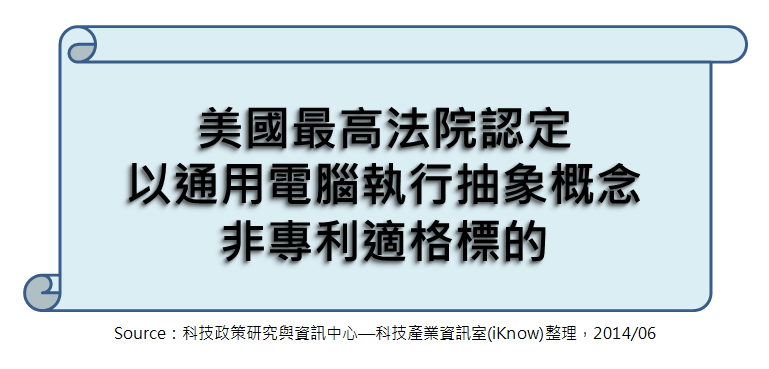
2014年6月19日,美國最高法院(the Supreme Court of the United States)做出Alice Corp. v. CLS Bank Int’l案判決(下稱本案判決),認定上訴人Alice Corporation所擁有、描述以電腦化架構來降低交易風險之系爭專利(US 5,970,479、6,912,510、7,149,720與7,725,375),其方法請求項、系統請求項、以及電腦可讀取記錄媒體請求項,均不符合美國專利法第101條(35 U.S.C.§101)規定、而為不具備專利標的適格性之發明。美國最高法院言明,前述系爭請求項所描述之發明均涉及中介交易之抽象概念,而僅是要求以通用電腦來執行之,並無法讓該抽象概念變成具專利標的適格性之發明(the claims at issue are drawn to the abstract idea of intermediated settlement, and that merely requiring generic computer implementation fails to transform that abstract idea into a patent-eligible invention)。
美國最高法院長期以來認定,自然法則(laws of nature)、自然現象(natural phenomena)與抽象概念(abstract ideas)不可專利(下稱不可專利標的,patent-ineligible concepts)。在本案判決中,美國最高法院指出,應區別以人類智能之「建構基礎」為其申請專利範圍之專利、以及整合前述建構基礎成為其他事物並藉以使其轉變成專利適格標的的專利(we must distinguish between patent that claim the “building block[s]” of human ingenuity and those that integrate the building blocks into something more…thereby “transform[ing]”them into a patent-eligible invention),前者不應受到專利保護而後者則具專利標的適格性。
美國最高法院進一步指出,過往判例(Mayo Collaborative Services v. Prometheus Laboratories, Inc., 566 U.S. ___ (2012))已建立分析架構,用來區別以不可專利標的為申請專利範圍之專利、以及以前述標的之具專利標的適格性應用為申請專利範圍之專利。
前述分析架構包括兩部分:第一,決定是否系爭請求項指涉其中一種不可專利標的(we determine whether the claims at issue are directed to one of those patent-ineligible concepts);第二,若前述問題答案為肯定,則判斷請求項是否包括其他內容,逐一並將之視為「有序之組合」來檢視個別請求項的構成要件,藉以決定這些附加之構成要件是否將請求項之本質轉變成具專利標的適格性之應用(we consider the elements of each claim both individually and “as an ordered combination” to determine whether the additional elements “transform the nature of the claim” into a patent-eligible application)。美國最高法院將前述第二分析步驟描述為尋找「發明概念」(inventive concept),其為一個構成要件或構成要件之組合,足以讓該專利實際上顯著多於不可專利標的之本身(an element or combination of elements that is “sufficient to ensure that the patent in practice amounts to significantly more than a patent upon the [ineligible concept] itself”)。
將前述分系架構應用於本案系爭專利,美國最高法院指出,系爭請求項指涉中介交易之概念,其為使用第三方來降低交易風險,而中介交易是在商業體系中長期被普遍使用的基本經濟行為,亦為現代經濟之一項建構基礎,所以其為不具專利標的適格性之抽象概念。
而由於系爭專利指涉中介交易之抽象概念,美國最高法院進一步進行分析架構之第二步驟分析,並認定系爭方法請求項僅要求以通用電腦來執行,並不能將抽象概念轉變成具專利標的適格性之發明。過往判例闡釋,發明描述一抽象概念並加上「將之付諸應用」的字眼並不足以使其具備專利標的適格性(stating an abstract idea “while adding the words ‘apply it’” is not enough for patent eligibility,Mayo, supra, at ___ (slip op., at 3)),而將抽象概念之使用限縮在一特定技術環境中亦同樣不足(nor is limiting the use of an abstract idea “to a particular technological environment”,Bilski v. Kappos, 561 U.S. 593, 610-611 (2010)),而美國最高法院認為,描述一抽象概念並加上「以電腦來應用之」(apply it with a computer)的字眼,僅是結合前述兩項動作但達到一樣的不足效果。美國最高法院指出,以通用電腦來執行通常並不屬於所謂的「附加技術特徵」,其具備讓人確信系爭方法發明並非意圖透過文字描述技巧來獨佔抽象概念本身的作用(wholly generic computer implementation is not generally the sort of “additional featur[e]”that provides any “practical assurance that the process is more than a drafting effort designed to monopolize the [abstract idea] itself”)。
美國最高法院認為,本案系爭方法請求項僅是指示實施者、在通用電腦上執行中介交易之抽象概念,其個別構成要件讓電腦所執行的功能,如創設與維護「影子」帳戶、獲取資料、調整帳戶金額、發出自動化指令等,均是相當慣常(purely conventional)的功能;而將之視為「有序之組合」來檢視,亦無增加任何額外功能效果。美國最高法院指出,系爭方法請求項僅描述由通用電腦來執行中介交易,其並未增加電腦本身功能性、或在其他技術領域中產生技術改良等,其僅是描述使用未特定之通用電腦來應用中介交易之抽象概念,如此不足以將該抽象概念轉變成具專利適格性之標的。
而就系爭專利之記錄媒體請求項與系統請求項,美國最高法院認為,其並未就抽象概念增加任何實質內容(add nothing of substance to the underlying abstract idea),所以亦非美國專利法第101條所規定之專利適格標的。就記錄媒體請求項,上訴人已同意,若方法請求項不可專利,則記錄媒體請求項亦不可專利。至於系統請求項,美國最高法院則是認為其與方法請求項並無實質差異:方法請求項是描述在通用電腦上執行抽象概念,而系統請求項則是描述一系列被配置來執行相同抽象概念之通用電腦元件。美國最高法院指出,解釋適用美國專利法第101條之方式,不應讓專利標的適格性是否成立、變成取決於專利撰寫者的描述技巧(this court has long “warn[ed]…against”interpreting §101 “in ways that make patent eligibility ‘depend simply on the draftman’s art’”),而若認定本案系爭專利之系統請求項具備專利標的適格性,則會導致出完全一樣的結果。(1982字)
資料來源:
--------------------------------------------------------------------------------------------------------------------------------------------